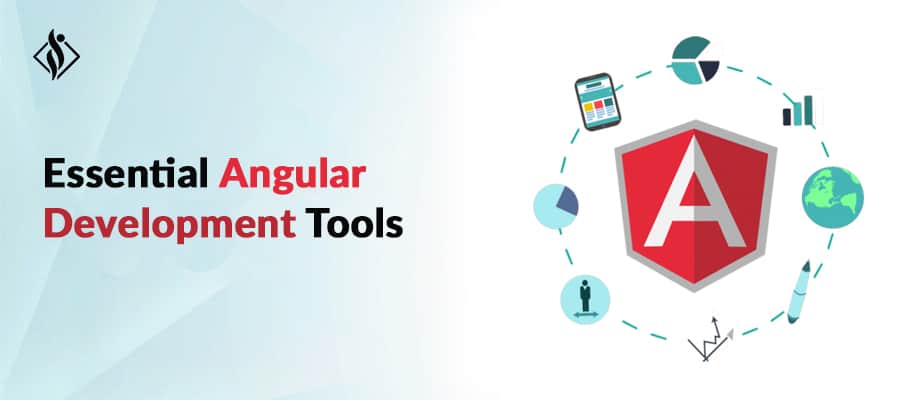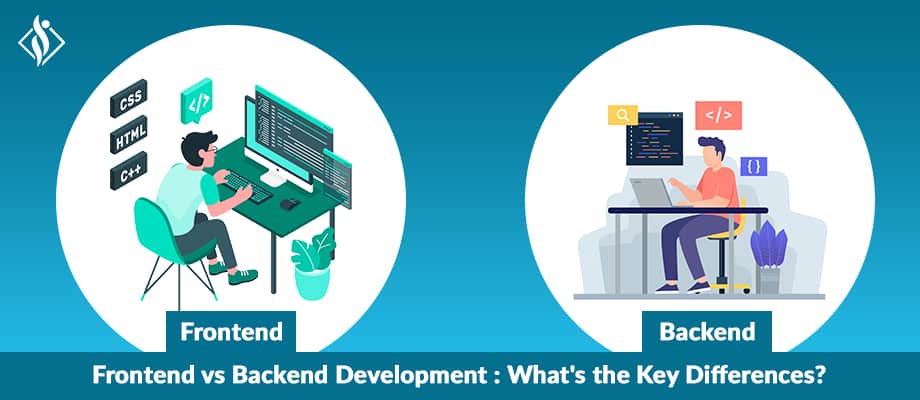Home » Front-end Development » Top 10 Front-End Web Development Tools & Frameworks For 2024(Updated)
Top 10 Front-End Web Development Tools & Frameworks For 2024(Updated)

These days, the online presence of a business has become the primary weapon to drive sales and boost revenue. With a feature-rich website, companies can easily reach their worldwide customers and turn them into potential leads.
However, having a website isn’t enough; it is also important that it can deliver a seamless browsing experience to the users.
Believe it or not, but user experience (UX) plays a crucial role in engaging a first-time buyer. It doesn’t matter how advanced features a website has, if it doesn’t have a user-friendly interface, it won’t contribute to the business growth.


Take a look at some of the most popular online platforms (Facebook, Instagram, YouTube), and you’ll find that all of them offer an easy-to-use interface to the users.
You can also achieve the same results by choosing the right tools for front-end web development. Having the right front-end tool & framework will help you design an interactive website, which will eventually captivate the visitors.
So, in this guide, we’ve compiled a list of top 10 front-end web development tools you can use in 2024 to design a user-friendly UI for your website.
Best Front-end Web Development Tools & Frameworks for 2024
- Angular
- React/ React.js
- Vue.js
- Ember.js
- KnockOut.js
- Backbone.js
- BootStrap
- CodePen
- Foundation
- jQuery
Angular

Angular is one of the most popular front-end JS frameworks that’s used by the majority of front-end developers. Since it is the only typescript-based web application framework, Angular is the most convenient tool to design large-scale web applications.
The original AngularJS framework was launched in 2010. However, due to its sudden downfall in 2013, after Facebook released React, Google decided to completely redesign it and include better features.
This is when Angular was introduced in the market in 2016. While Google did take 3 years to redesign the framework, it’s safe to say that the final product was worth the wait. It has an extensive range of features that separate it from other web frameworks in the market.
For instance, Angular offers two-way data binding that allows real-time interaction between the Model and the View. Any small change in the Model will instantly reflect in View, allowing developers to track real-time changes.
Whether you’re looking forward to designing a single page or multi-page web app, Angular will help you achieve the desired goals.
Key Features
- Angular web development framework is a highly efficient tool that reduces the amount of code, thanks to the two-way data binding feature.
- Angular allows developers to extend HTML syntax for different web applications.
- Angular is backed by a technically-skilled community of developers who always focus on improving the framework by adding better features.
- In terms of security, Angular is the most advanced web development frameworks right now. Unlike other frameworks, Angular is safe from cross-site scripting attacks.
Further Read: Hire Angular Developers in India: Things to keep in mind
React

React is yet another JavaScript-based front-end framework that is used by a large number of front-end developers. In fact, React was the main reason why Google had to step-down and re-design AngularJS in 2013.
Designed by a team of passionate coders at Facebook, React has completely changed the dynamics of front-end development. React is a component-based web framework that utilizes one-way data flow.
However, the main selling point of React is Virtual DOM (Document Object Model). In any web framework, manipulating the DOM is a challenging task. Since React keeps a virtual DOM in memory and only updates the real DOM in batch, it becomes easier to manipulate the DOM.
React is the perfect choice for developers who are looking forward to designing feature-rich single-page web applications.
Let us Compare: Angular vs. React: Which is Better for Your Web Apps Development?
Key Features:
- Being a component-based web framework, React allows developers to reuse components in other parts of the web applications.
- React is being used by Facebook in the majority of its applications, which means it’s one of the most reliable front-end web frameworks in JavaScript.
- Virtual DOM allows developers to design highly-interactive web pages.
- React also offers SEO support, allowing developers to easily optimize their websites for better search engine rankings.
Related Article: How to Hire Top ReactJS Developers? Complete Guide
Vue.js

Vue.js is among the top open-source web development tools you can try in 2024 to create simple as well as dynamic web applications. Vue.js is an amalgamation of the best features of AngularJS and React.
It was designed in 2014 by a Google Software engineer, Evan You. The idea was to combine the good parts of AngularJS and React together to design a feature-rich web framework for front-end development.
Unlike Angular and React, Vue.js reduces the complexities and allows developers to reuse code in multiple web applications, reducing the overall development time. It also offers flexible APIs that can be used to design an array of web applications.
Considering its versatile nature, tech-giants like Alibaba and Xiaomi have already switched to Vue.js.
Key Features:
- Less Complicated. Developers having a JavaScript background can easily work in Vue.js without facing any issues.
- It offers two-way data binding.
- After Angular, Vue.js is going to be the second framework to support typescript. Vue.js has added a completely new library in the upcoming version which will also support TypeScript.
- Vue-router makes it easy to navigate between different components of the applications.
Emberjs

Like jQuery, Ember.js is also one of the earliest open-source web development tools available in the market. It was initially designed and released by Apple under a different nametag, i.e., Sprout Core.
However, later in 2011, Apple relaunched it as Emberjs and since then it’s been used to develop different types of web applications. Thanks to its highly efficient architecture, Emberjs can be used to develop feature-rich web & mobile applications.
The only downside to Emberjs is its steep learning curve. Among all the frameworks, Emberjs is the most difficult to learn, even if you have enough experience in JavaScript coding.
Basically, if you’re looking to start with a new technology and are willing to invest your time in learning, Emberjs might be the right choice for you. Once you understand its functionality, it’ll become easier to develop robust web applications with excellent features.
Key Features:
- Emberjs supports two-way data binding.
- Unlike other web frameworks, Emberjs isn’t backed by a single corporation. Instead, a community of developers works on improving the functionality of the framework.
- Emberjs is well-organized which makes it easier to work on enterprise-level web applications that have multiple modules.
KnockOut.js

Over the past couple of years, knockout.js development has become quite popular across the globe. Knockout.js is a simple and straightforward JavaScript framework that’s widely used to create a responsive user-interface.
Knockout.js is based on the MVVM (Model View View-Model) paradigm, which makes it the right choice to develop dynamic web applications. Even though knockout.js is an old framework, it’s being continuously improved to offer rapid front-end web development.
While it may not be the right choice to develop a large-scale enterprise-level web application, you can definitely use it to design normal web apps with limited features.
Key Features:
- Like Angular, KnockOut.js supports two-way data binding.
- It is an independent framework that doesn’t rely on other JavaScript libraries like jQuery.
Backbone.js

Backbone.js is a JavaScript library that’s mainly used to design single-page web applications with fewer complications. Backbone.js utilizes events for communication, which means that it’ll be easier to organize different modules while designing the user interface.
It is one of the lightweight front-end JS frameworks that’ll give structure to client-side codes. It uses various building blocks including events, routers, and views to organize data. As a result, you’ll have a well-organized and 100% cleaner code for your applications.
Key Features:
- A lightweight framework perfect to design SPAs (Single-Page Applications).
- Easy to Learn.
- Easier to organize and manage code.
Bootstrap

Bootstrap is a remarkable HTML, CSS, and JavaScript framework that’s perfect to design responsive mobile-first layouts for your web applications. Bootstrap offers several pre-defined CSS and JavaScript templates that make it way easier for the developers to design responsive layouts instantly.
Bootstrap also offers an array of jQuery plugins that allow developers to add additional UI elements such as dialog boxes. If you are interested in designing responsive web pages that offer exceptional cross-platform compatibility, Bootstrap is the right choice.
Key Features:
- Pre-defined JavaScript Components for quick front-end development.
- It provides an extensive range of jQuery plugins.
CodePen

CodePen is one of a kind front-end tools for web development that can be used to create and test modules while collaborating with other front-end developers at the same time. The platform basically allows front-end developers to design small pens (sets of HTML, CSS, and JavaScript codes) and share them on their profiles.
This will allow other developers in the community to share feedback on these pens, allowing everyone to learn in a real-time environment. CodePen is an extremely useful web development tool for developers who are just starting with their careers.
Since it has a large community of experienced developers, you can share your snippets to learn from experts. CodePen also allows rookie developers to take inspiration from other impressive “Pens” and use them to design interactive User Interface for their own website.
Key Features:
- CodePen has a dedicated interface to quickly write CSS codes.
- It also supports “private pens” which you can use to securely share your code snippets with specific people.
- You can securely create and store assets in the pro-version of CodePen.
Foundation

So far, we’ve only talked about front-end web development frameworks that can be used to create small-scale as well as enterprise-level web applications. However, that’s not the case with Foundation. It is an advanced web framework only meant for experienced front-end developers.
If you are a beginner, it’ll become quite challenging to design an interactive UI using Foundation.
However, for advanced enterprise-level development, Foundation is the perfect choice. It allows developers to design highly interactive websites that deliver an exceptional browsing experience.
Features like GPU acceleration makes it easier to add smoother transitions between different elements of a web page.
Key Features:
- Foundation lets developers create a customized user-interface that looks fresh and completely out-of-the-box.
- It also allows developers to create Multi-lingual websites.
- Built-in CSS modules allow quick integration.
jQuery

Despite being one of the earliest additions to the web development tools list,
jQuery has all the features you’ll need to develop an interactive user-interface in the modern world. jQuery is a JavaScript library that’s primarily used to manipulate the DOM.
It can be used to handle different front-end activities like creating animations and handling different events. With jQuery, furthermore, developers don’t have to write lengthy JavaScript codes, which promotes quick and effective front-end development.
Apart from offering ease-of-use, jQuery also supports cross-platform compatibility, making it easier for the developers to test their web applications on different platforms.
Key Features
- Being one of the earliest, front-end frameworks, there’s a large community of developers who provide effective solutions instantly.
- jQuery supports flexible DOM which makes it easier to add and remove elements quickly.
- Code-reusability saves developers from writing extensive JavaScript codes as a single code can be used in multiple web applications.
- As compared to other web frameworks, sending HTTP requests is way simple in jQuery.
Conclusion
That concludes our list of top 10 front-end web frameworks in JavaScript. Since there are too many options to choose from, it might get a bit challenging to pick the right front-end development tool for your project.
However, keep in mind that each of these tools have pros and cons of their own. So, make sure to analyze your project requirements first and then choose the most suitable front-end framework accordingly.
We’re always happy to assist you with your web development requirements. Contact us to discuss further.
I work as a Sr. Software Developer at Samarpan Infotech with the latest technologies & taking responsibility for architectural systems research and development. A result driven professional, articulate & analytical senior software developer who build while(noSuccess){ tryAgain(); } solutions, having expertise in software & database architecture planning and designing.



